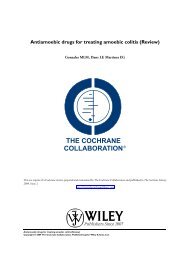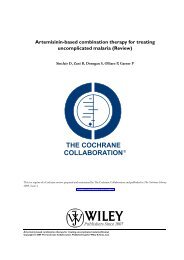Interventions for treating proximal humeral fractures in adults (Review)
Interventions for treating proximal humeral fractures in adults (Review)
Interventions for treating proximal humeral fractures in adults (Review)
Create successful ePaper yourself
Turn your PDF publications into a flip-book with our unique Google optimized e-Paper software.
B A C K G R O U N D<br />
Proximal <strong>humeral</strong> <strong>fractures</strong> account <strong>for</strong> four to five per cent of<br />
all <strong>fractures</strong> and are about half as common as hip <strong>fractures</strong>. The<br />
<strong>in</strong>cidence rapidly <strong>in</strong>creases with age, and women are affected over<br />
twice as often as men (Horak 1975; Kristiansen 1987). Many patients<br />
who susta<strong>in</strong> a <strong>proximal</strong> <strong>humeral</strong> fracture are elderly and<br />
their bones are osteoporotic. A recently published study found<br />
that 87% of these <strong>fractures</strong> <strong>in</strong> <strong>adults</strong> resulted from falls from a<br />
stand<strong>in</strong>g height (Court-Brown 2001). Bone quality also <strong>in</strong>fluences<br />
the appropriateness of any <strong>in</strong>tervention and hence long term cl<strong>in</strong>ical<br />
outcome. Furthermore, the patient’s frailty may lead to a low<br />
rehabilitation drive and delay any recovery from both the <strong>in</strong>itial<br />
trauma and any subsequent management.<br />
The majority of <strong>proximal</strong> <strong>humeral</strong> <strong>fractures</strong> are not displaced or<br />
only m<strong>in</strong>imally displaced. Neer’s estimate (Neer 1970) that approximately<br />
85% of all <strong>proximal</strong> <strong>humeral</strong> <strong>fractures</strong> are “undisplaced”,<br />
<strong>in</strong> that no bone fragment is displaced by more than one<br />
centimetre, or angulated more than 45 degrees is often cited (Koval<br />
1997). A lower figure of 49% is reported <strong>in</strong> a prospective study of<br />
over 1000 <strong>proximal</strong> <strong>humeral</strong> <strong>fractures</strong> (Court-Brown 2001). For<br />
these <strong>fractures</strong>, conservative treatment is generally the preferred<br />
option. The arm is immobilised to ma<strong>in</strong>ta<strong>in</strong> fracture stability and<br />
to provide pa<strong>in</strong> relief dur<strong>in</strong>g heal<strong>in</strong>g. This is usually followed by<br />
physiotherapy and exercises aimed at restor<strong>in</strong>g the function and<br />
mobility of the <strong>in</strong>jured arm. Surgery is usually reserved <strong>for</strong> displaced<br />
and unstable <strong>fractures</strong> and those with more complicated<br />
fracture patterns. Surgical stabilisation of the fracture may also allow<br />
earlier movement of the shoulder and elbow, prevent<strong>in</strong>g stiffness.<br />
The most commonly used classification of shoulder <strong>fractures</strong> is<br />
that of Neer (Neer 1970). He considered four segments of the<br />
<strong>proximal</strong> humerus - the articular part, the greater tuberosity, the<br />
lesser tuberosity and the <strong>humeral</strong> shaft - that might be fractured<br />
off and displaced from each other. All <strong>fractures</strong>, regardless of the<br />
number of fracture l<strong>in</strong>es present, which did not meet the criteria <strong>for</strong><br />
displacement (stated above) of any one segment with respect to the<br />
others were considered “undisplaced” and categorised as one-part<br />
<strong>fractures</strong>. Neer’s other categories, two-part, three-part and fourpart<br />
<strong>fractures</strong> all <strong>in</strong>volved the displacement of some or all of the<br />
above four segments. Each of these may be potentially associated<br />
with an anterior or posterior <strong>humeral</strong> head dislocation. At <strong>in</strong>itial<br />
presentation, it may be difficult to del<strong>in</strong>eate the exact pattern of<br />
the fracture even with sophisticated imag<strong>in</strong>g. In any event, this<br />
may not correlate with the degree to which avascularity (loss of<br />
blood supply) may develop with<strong>in</strong> the <strong>humeral</strong> head. Surgeons<br />
have often followed Neer’s premise (Neer 1975) that <strong>in</strong> a four-part<br />
fracture head necrosis is virtually guaranteed and have offered their<br />
patients a replacement arthroplasty, where the <strong>humeral</strong> head or all<br />
of the shoulder jo<strong>in</strong>t is replaced by artificial parts. An exception is<br />
made <strong>for</strong> a specific type of four-part fracture, the valgus impacted<br />
four-part fracture, not mentioned <strong>in</strong> Neer’s classification. This<br />
fracture is less likely to lead to avascular necrosis of the <strong>humeral</strong><br />
head, provided lateral displacement of the head fragment is not<br />
excessive (Jakob 1991; Resch 1997).<br />
Aside from conservative treatment, generally <strong>in</strong>volv<strong>in</strong>g immobilisation<br />
of the <strong>in</strong>jured arm, surgical <strong>in</strong>terventions considered <strong>in</strong>clude:<br />
• Closed reduction and stabilisation with percutaneous<br />
Kirschner wires<br />
• External fixation<br />
<strong>Interventions</strong> <strong>for</strong> <strong>treat<strong>in</strong>g</strong> <strong>proximal</strong> <strong>humeral</strong> <strong>fractures</strong> <strong>in</strong> <strong>adults</strong> (<strong>Review</strong>)<br />
Copyright © 2008 The Cochrane Collaboration. Published by John Wiley & Sons, Ltd.<br />
• Open reduction and plat<strong>in</strong>g (AO <strong>humeral</strong> buttress plate,<br />
angle blade plates)<br />
• Open reduction and wir<strong>in</strong>g us<strong>in</strong>g a tension-band pr<strong>in</strong>ciple<br />
• Intramedullary nail<strong>in</strong>g either antegrade or retrograde: <strong>for</strong><br />
example, Rush p<strong>in</strong>s, Seidel, AO, Richards, Marchietti and<br />
Halder nails<br />
• Hemi-arthroplasty (replacement of the <strong>humeral</strong> head) or<br />
total shoulder replacement<br />
O B J E C T I V E S<br />
This review aims to determ<strong>in</strong>e the most appropriate treatment<br />
<strong>for</strong> <strong>fractures</strong> of the <strong>proximal</strong> humerus <strong>in</strong> skeletally mature people<br />
(<strong>adults</strong>).<br />
We aimed to exam<strong>in</strong>e the evidence from randomised and quasirandomised<br />
controlled trials <strong>for</strong> the effects (benefits and harms)<br />
of different treatment, <strong>in</strong>clud<strong>in</strong>g rehabilitation, <strong>in</strong>terventions <strong>in</strong><br />
<strong>adults</strong> with <strong>fractures</strong> of the <strong>proximal</strong> humerus. We def<strong>in</strong>ed a priori<br />
the follow<strong>in</strong>g broad objectives:<br />
• To compare different methods of conservative treatment<br />
(<strong>in</strong>clud<strong>in</strong>g rehabilitation)<br />
• To compare surgical versus conservative treatment<br />
• To compare different methods of surgical treatment<br />
• To compare different methods of rehabilitation after<br />
surgical treatment<br />
We planned to study the outcomes <strong>in</strong> different age groups (<strong>in</strong>itially,<br />
under versus over 65 years) and <strong>for</strong> different types of <strong>fractures</strong>.<br />
3








